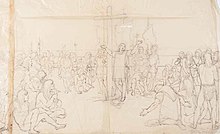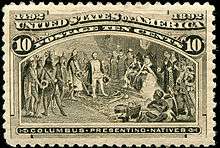Columbus murals
The Columbus murals are a series of twelve murals depicting Christopher Columbus, painted in the 1880s by Luigi Gregori and displayed in the Main Building at the University of Notre Dame in Indiana, US. The murals have been a source of controversy in recent decades for their romanticized portrayal of Columbus and his relationship with Native Americans.
University founder Edward Sorin commissioned Gregori, an Italian artist who had previously worked for the Vatican, to paint the series, which he completed from 1881 to 1884. Columbus was chosen as the subject because he was seen by Americans as a heroic figure at the time, particularly by Catholics who were facing Anti-Catholic sentiment. As such, Columbus is painted in a saintly manner, while the natives are shown as submissive and filled with awe. In recent decades, however, the murals have faced criticism for their historical inaccuracies and prominent position in Notre Dame's primary administration building.
History

In 1874, founder and former university president Edward Sorin visited the Vatican and hired Luigi Gregori, an artist-in-residence there, to be an art professor at Notre Dame.[1] An 1879 fire destroyed the campus's Main Building, but it was rebuilt during that summer; two years later, Sorin commissioned Gregori to create a collection of artwork to decorate the first floor[lower-alpha 1] of the new Main Building.[3]
In the nineteenth century, Americans thought of Columbus as a heroic figure and a symbol of independence, progress, and faith, which went along with the manifest destiny movement.[4] Columbus was also an appealing figure to Notre Dame's faithful population, as Catholics had rallied behind the him as a rare Catholic contributor to the mostly Protestant history of the US.[4] The figure also helped fight the nineteenth-century nativism movement, particularly against Italian Americans, and anti-Catholic sentiment—stemming from the view that Catholics were loyal to the pope before their country.[5][6]
Gregori began the first painting, called Christopher Columbus, Explorer, in mid-November 1881 and finished it before the end of the year.[7] He painted the other eleven murals from 1882 to 1884, completing each one as funds were donated by faculty and other private individuals.[3][8] He used pigment with casein paint to do his work on the plaster walls.[9] However, the plaster was dry, so they are not true frescoes.[10]
At the time, scholars disputed Columbus's physical appearance, and no authoritative portrait existed, so Gregori used then-current president Thomas E. Walsh as the model for Columbus's face in all but one mural and Sorin for Columbus on his deathbed.[11][12] Notre Dame faculty, Congregation of Holy Cross members, benefactors, and Gregori himself also served as models for other people in the murals.[7][10][13][14]
Contemporary accounts and descriptions of the murals are complimentary and reflect the positive image of Columbus. An account in the New York Freeman's Journal, published in 1886 in the Notre Dame Scholastic, says that "some of [the] students are young and careless; but the pictures are treated with respect, almost with reverence, and no boyish hand has attempted to deface the walls".[15]

In honor of the 1893 World's Columbian Exposition, the Columbian Issue, a set of sixteen commemorative postage stamps, was created, and the 10¢ stamp was based on The Reception at Court mural.[16]
Description
The murals are each 11 feet (3.4 m) tall, ranging in width from 5.5 to 19 feet (1.7 to 5.8 m).[17]. They are all located in a hallway south of the central rotunda of the Main Building.[10] The twelve paintings are:[10]
- Christopher Columbus, Discoverer[18] or Christopher Columbus, Explorer[19]—It shows Columbus standing tall next to a globe, in an akimbo posture with his hand on his hip, suggesting importance and influence.[19] He points to North America on the globe, although he never recognized that he had landed on the continent.[18]
- Isabella the Catholic, Protectress of Columbus
- Columbus at the Gate of the Convent of La Rabida
- Father Perez Blesses Columbus before He Embarks
- The Mutiny at Sea
- Discovery of Land, Friday, October 12, 1492 or Sighting of Land, Friday, October 12, 1492
- Taking Possession of the New World or Columbus Coming Ashore
- Return of Columbus and Reception at Court
- Bobadilla Betrays Columbus
- Death of Columbus, Valladolid, May 20, 1506
- Father Diego de Deza, Protector of Columbus at Salamanca—It depicts Diego de Deza, the son of Ferdinand and Isabella, who helped Columbus gain access to them.
- Luis de Santangel, Treasurer of Aragon—Luis de Santángel helped Columbus secure funding for his voyage.
The murals portray Columbus in a saintly light, and Gregori painted scenes showing Columbus as doing God's work.[20] The Reception at Court depicts Columbus presenting treasures of the New World to King Ferdinand II and Queen Isabella I of Spain: pineapples, nuts, spices, gold figurines, a parrot, as well as several Taíno people.[9][21] The presence of a large number of clergy indicates that the natives are to be baptized. A large crowd watches behind them, and in the background is a fleet of ships.[22]
There are numerous historical inaccuracies in the murals. In The Reception at Court, for example, the natives are depicted holding shields which northern Plains Indians would use and wearing Mandan clothes, whereas Columbus actually encountered the Taíno of the Caribbean.[22] The inaccuracies are attributed to a combination of ignorance (at the time, Native Americans were seen as a monolithic group, rather than a diverse group of tribes)[9] and intentional symbolism (Notre Dame's founding Holy Cross missionaries encountered Plains Natives).[23] Furthermore, Gregori may have drawn inspiration from Notre Dame's own collection of artifacts.[9]
Controversy
In 1997, a faculty committee created a brochure to offer historical context to the murals, saying that "the University of Notre Dame recognizes that the Columbus murals reflect 19th-century white European views of race, gender and ethnicity which may be offensive to some individuals".[24]
A 2017 letter to the editor of Notre Dame's student newspaper, The Observer, signed by over 300 students, employees, and alumni, called for the murals to be removed. In January 2019, university president John I. Jenkins announced a plan to cover the murals.[25]
See also
Notes
- "First floor" refers to the floor above the ground floor, following the European scheme of floor numbering.[2]
References
- Meyers 2012, pp. 14–15.
- Sullivan 1951, p. 31.
- Meyers 2012, p. 17.
- Meyers 2012, pp. 17–18.
- Lindquist 2012, p. 9.
- Doss 2018, p. 10.
- Murch 1920, p. 115.
- Scholastic 1881.
- Meyers 2012, p. 53.
- Schlereth 1977, p. 242.
- Meyers 2012, pp. 44, 57.
- Tucker 2018, p. 38.
- Meyers 2012, p. 57.
- Lamb & Hogan 2017, p. 47.
- Scholastic 1886.
- Schlereth 1992, p. 951.
- Barrenechea & Moertl 2013, p. 109.
- Barrenechea & Moertl 2013, p. 110.
- Meyers 2012, p. 44.
- Meyers 2012, p. 19.
- Schlereth 1992, pp. 951–952.
- Schlereth 1992, p. 952.
- Lindquist 2012, p. 8.
- Doss 2009, p. 138.
- Katz 2019.
Sources
Journals and books
- Barrenechea, Antonio; Moertl, Heidrun (November 2013). "Hemispheric Indigenous Studies: Introduction". Comparative American Studies. 11 (2): 109–123. doi:10.1179/1477570013Z.00000000041.
- Doss, Erika (June 2009). "Action, Agency, Affect: Thomas Hart Benton's Hoosier History". Indiana Magazine of History. Indiana University Press. 105 (2): 127–139. JSTOR 27792974.
- Doss, Erika (December 2018). "The Elephant in the Room: Prejudicial Public Art and Cultural Vandalism". de arte. 53 (2–3): 4–30. doi:10.1080/00043389.2018.1481909.
- Lamb, Charles; Hogan, Elizabeth (2017). Notre Dame at 175: A Visual History. Notre Dame, Indiana: University of Notre Dame Press. ISBN 9780268102456. JSTOR j.ctvpj7bj9.
- Lindquist, Sherry C. M. (Spring 2012). "Memorializing Knute Rockne at the University of Notre Dame: Collegiate Gothic Architecture and Institutional Identity". Winterthur Portfolio. 46 (1): 1–24. doi:10.1086/665045. JSTOR 10.1086/665045.
- Meyers, Sophia (2012). Artist in Residence: Working Drawings by Luigi Gregori (1819–1896) (PDF). Notre Dame, Indiana: Snite Museum of Art. Retrieved June 14, 2020.
- Schlereth, Thomas J. (1977). The University of Notre Dame: A Portrait of Its History and Campus (2nd ed.). Notre Dame, Indiana: University of Notre Dame Press. ISBN 0-268-01906-1.
- Schlereth, Thomas J. (December 1992). "Columbia, Columbus, and Columbianism". The Journal of American History. Oxford University Press. 79 (3): 937–968. doi:10.2307/2080794. JSTOR 2080794.
- Sullivan, Richard (1951). Notre Dame. New York City: Henry Holt and Company. OCLC 1416056.
- Tucker, Todd (2018). Notre Dame vs. The Klan: How the Fighting Irish Defied the KKK. Notre Dame, Indiana: University of Notre Dame Press. ISBN 9780268104368. JSTOR j.ctvpj7dt2.
Newspapers and websites
- "A thing of beauty is a joy forever" (PDF). Notre Dame Scholastic. 15 (10). November 12, 1881. pp. 140–141. Retrieved June 13, 2020.
- Katz, Brigit (January 25, 2019). "Notre Dame University Will Cover Controversial Columbus Murals". Smithsonian. Retrieved June 12, 2020.
- "Luigi Gregori—Director of the Art Department in the University of Notre Dame". The Notre Dame Scholastic. 20 (4). September 25, 1886. p. 66. Retrieved July 1, 2020.
- Murch, Raymond M. (November 13, 1920). "Luigi Gregori—Notre Dame's Artist" (PDF). The Notre Dame Scholastic. 54 (8). pp. 113–116. Retrieved July 4, 2020.
